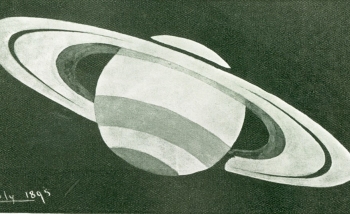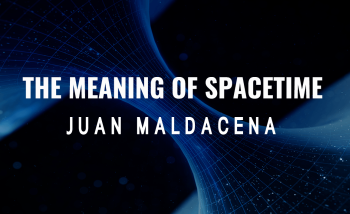Avery Broderick wants to capture the first image of a black hole. And he is not alone.
Broderick is a member of the Event Horizon Telescope (EHT) project: a scientific collaboration that spans continents and disciplines, uniting hundreds of researchers with the shared goal of capturing a black hole on camera and unlocking the secrets that lurk beyond its point-of-no-return event horizon.
The EHT is an array of interconnected telescopes around the world that, in ensemble, become essentially an Earth-sized telescope. Fittingly, and almost by necessity given the project’s complexity, the scientists behind the EHT also work best together.
That is why Broderick invited over 100 of them to the EHT 2014 conference at Perimeter Institute last November. It was a pivotal conference, as the EHT project is expected to begin collecting data this year on the supermassive black hole believed to be the engine of our Milky Way galaxy, Sagittarius A*.
Broderick is also leading the new EHT Initiative at Perimeter – a growing research team devoted to analyzing the torrent of data that will soon arrive from the EHT. Inside the Perimeter chatted with Broderick about how – and why – he and his colleagues are
determined to look into the belly of the gravitational beast.
Inside the Perimeter: What is your role in the EHT research?
Broderick: They don’t let me touch the telescopes. That’s a good thing. I get what I like to call “highly massaged data products.” After a number of radio astronomers and very excellent scientists take the data that was collected, run it through all kinds of algorithms, and make sure all the i’s are dotted and the t’s are crossed, they give me something that’s very simplified but that encodes the physical structure of the image they saw. My job is to take everything we know about how black holes are supposed to work and construct models to compare to those image structures and, based on that comparison, tease out the things that we don’t know, explain the parts we don’t understand. One of those, of course, is understanding gravity, right near the horizon, right where material goes in.
Inside: The EHT is expected to obtain the first “picture” of a black hole. How important is this?
Broderick: Images have a strong visceral impact on us. From a very early age we’re developing our ability to see the world around us. When we see something, we somehow connect with it, and that’s one reason why astronomy is such a fun thing. I get to go show people pictures and they understand in large part right away what I’m talking about. But if you want to know how these things work, if you want to achieve the fundamental science drivers for the EHT, if you want to achieve the reasons why we’re doing all this, an image isn’t enough. You have to interpret the image. You have to look at the exciting features in the image and tease out the physics that made them look the way they did. And that means there’s a strong input from people who model these systems. There’s a strong input from theoreticians to analyze that data. Without those theoreticians, getting from the image to science just gets that much harder.
Inside: As a theorist, what are you expecting to learn from the EHT data?
Broderick: Well, I don’t know. It could run the gamut. For example, we don’t know why the black hole at the centre of our galaxy shines, but we have a lot of ideas. We don’t know if it shines because it’s emitting a jet, or if it’s because there’s an accretion flow. These two processes have to be closely related. We just don’t know which one’s lighting it up. It’s kind of like not knowing whether we’re seeing the turning signal or the headlights on the car. We’re going to find that out from that image. Another thing we hope to do, by measuring the shape of that shadow and from the dynamics of stuff going around the black hole, is to test general relativity right near black holes. If we see some funny shape, we’ll know something is up. If we don’t, we’ll know Einstein was right.
Inside: And if Einstein wasn’t right, what then?
Broderick: Well, first we have a party. That would be super exciting. That’s when the hard work begins. And that’s why we need to do this at someplace like Perimeter, because we’d have to sort out the theory to replace general relativity. So the default assumption is always that general relativity is the correct theory of gravity. Einstein is almost certainly right; it’s just never been historically a good idea to stake your career on assuming Einstein was wrong. On the other hand, maybe he’s not right. Maybe we find that general relativity doesn’t work near the horizons of black holes. And then the sky’s the limit. With black holes, there’s a real chance that we’re going to find our understanding of fundamental physics is completely wrong. And every time somebody goes off the edge of the map, they come back with something new and exciting and totally unexpected. This is a chance to do that. This is exploration in its truest sense, and we don’t know what we’re going to find.
Inside: Is that what motivates you – the exploration?
Broderick: Some people like to commute to their office every day and I like to take flights of fancy in spaceships. That’s what I do. I travel to the stars and I go see the most exotic physics that we can understand right now. That’s my job. And unfortunately, I don’t get to do it in my spaceship and I don’t get to do it on the train. I do it on computers and I view it in telescopes. But it’s my way of exploring, which I think is this fundamental human drive we all share to get out there and see what’s there. It’s not for us to decide what’s right. It’s up to nature. It’s up to observations.
About PI
Perimeter Institute is the world’s largest research hub devoted to theoretical physics. The independent Institute was founded in 1999 to foster breakthroughs in the fundamental understanding of our universe, from the smallest particles to the entire cosmos. Research at Perimeter is motivated by the understanding that fundamental science advances human knowledge and catalyzes innovation, and that today’s theoretical physics is tomorrow’s technology. Located in the Region of Waterloo, the not-for-profit Institute is a unique public-private endeavour, including the Governments of Ontario and Canada, that enables cutting-edge research, trains the next generation of scientific pioneers, and shares the power of physics through award-winning educational outreach and public engagement.
You might be interested in

Spiralling light from M87’s supermassive black hole reveals strong magnetic fields
November 8, 2023

